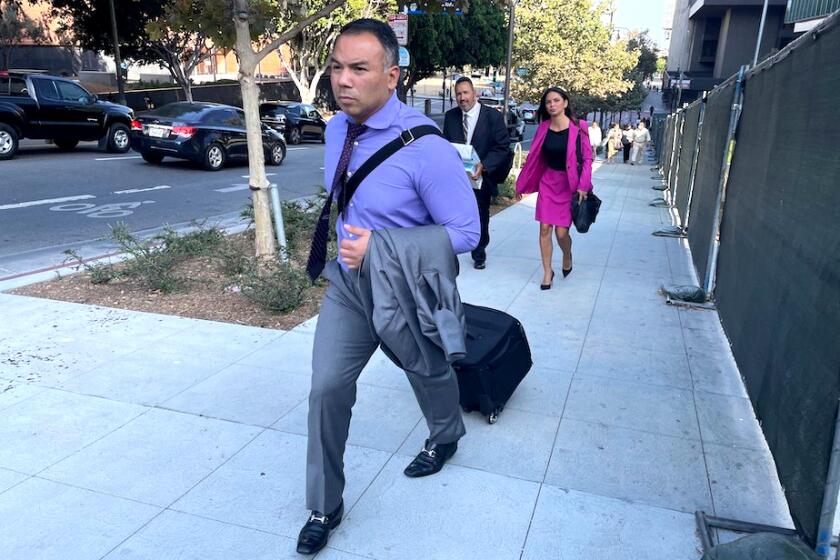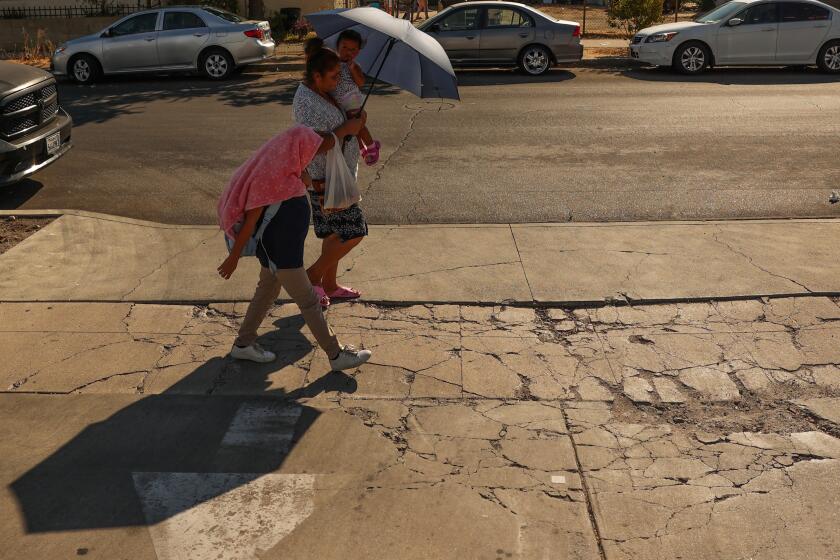CAO: Report Backs a Combined Office of Sheriff-Coroner : Report to Board Urges Some Changes : Combined Orange County Sheriff-Coroner Endorsed
A long-awaited Orange County report issued Tuesday endorsed the present consolidated operations of the sheriff-coroner’s office, just minutes after Sheriff-Coroner Brad Gates helped persuade an Assembly committee in Sacramento to kill a bill that would have forced separation of the two offices in heavily populated counties.
The report prepared by the county administrative office said that separating the two offices would be too costly and that the present coroner’s operation “was found to operate in a very efficient, effective and professional manner . . . with generally good working relationships with law enforcement.”
The supervisors ordered the CAO report last December after hearing complaints that Gates was involved in a conflict of interest in an investigation of a death in the County Jail. Gates, acting as sheriff, had confiscated the mental health records of inmate John Ray Stephenson, who died on Nov. 6, 1984, and turned them over to coroner’s officials despite protests from the county mental health team at the jail that the records were confidential.
The CAO report does recommend independent inquiry by the district attorney’s office into in-custody deaths and deaths involving law enforcement officers. It also recommended that the office be reorganized so that Deputy Coroner James Beisner would answer directly to Gates instead of a layer of deputies under the sheriff, as he does now.
But the report states that deaths where a conflict of interest might arise amount to just 0.5% of the coroner’s caseload, and that separating the sheriff’s and coroner’s office would not eliminate potential conflicts of interest between the coroner’s office and other county agencies.
The Board of Supervisors is expected to vote in the next two weeks whether to adopt a plan to separate the two offices, but the CAO report effectively kills any attempts to tamper with Gates’ operation.
Supervisor Bruce Nestande, who told the board in December that he was concerned about a possible conflict of interest in the consolidated sheriff-coroner’s office, said Tuesday that the CAO report would have “substantial impact” on the board’s vote next week.
‘Just One Piece of Data’
“It’s just one piece of data that I’ll be basing my opinion on . . . . Certainly this is a very important piece of information.”
Gary Granville, a spokesman for Supervisor Ralph Clark, said Clark thinks the present sheriff-coroner system works well. “If shown otherwise, his opinion could shift, but so far it hasn’t,” Granville said.
The other three supervisors said they would have no comment until they had read the report thoroughly.
In Sacramento, the Assembly Local Government Committee voted 6 to 2 Tuesday against a bill that would have forced separation of the two offices in all counties with a population of 200,000 or more. Committee members against the bill said the issue should be decided at the county level.
Currently, state law allows counties to split the two offices or consolidate them.
Gates told the legislators, “The system we have is an excellent one.”
Later, apprised of the CAO report, Gates said it “reflects a high degree of confidence in the integrity of the folks running the coroner’s office.”
Ferguson to Try Again
One of the leading advocates of separate offices for the sheriff and coroner is Assemblyman Gil Ferguson (R-Newport Beach) who introduced the proposal killed by the Assembly committee Tuesday.
Ferguson said he will try to get the bill reconsidered May 7 and plans to bring survivors of persons who have died in jails with sheriff-coroner operations as witnesses.
Ferguson’s bill has been endorsed by the American Civil Liberties Union and the California Attorneys for Criminal Justice.
Gates and Ferguson argued bitterly in a hallway after Tuesday’s hearing, with Gates accusing the assemblyman of picking the May 7 date because he knew Gates would probably have to appear before the supervisors then. Ferguson denied it.
Actually, while the supervisors said they would vote on May 7, it’s likely that the vote won’t be until the following week. The supervisors Tuesday asked Larry Holms, acting county administrative officer, for another report on the performance of the private pathologists who handle autopsies for the coroner’s office. Clark’s and Nestande’s offices said the vote on both issues will probably take place May 14.
Conflict Questions Remain
While Nestande said he was impressed with the report, he still has questions about conflict of interest.
The CAO report concedes, “A perception of conflict of interest continues to persist” in jail deaths and deaths involving law enforcement officers. But it adds that potential or perceived conflicts may also exist if the coroner function is assigned to either a health care agency or a community services agency.
“I have to satisfy in my own mind how you get rid of actual and perceived conflicts,” Supervisor Nestande said.
The CAO study, directed by Holms, states that while there are weaknesses in the present system there would be weaknesses in alternative systems, too.
There are 36 counties out of 58 in California that have a combined sheriff-coroner’s office, though Orange County is the only county with a million-plus population using the system. Other major counties use either a professional medical examiner or a non-medical (lay) coroner separate from the sheriff.
The CAO report states that these types of coroners “generally have poorer working relationships with law enforcement agencies than sheriff-coroners.” But it adds that lay coroners often have better administrative skills and that medical examiners are often more acceptable to the medical community.
Chain of Command
The major change recommended in the study would be in the organizational chart of who answers to whom under Gates.
At present, Deputy Coroner Beisner answers to Larry Ragle, director of forensic sciences. Ragle answers to Walter Fath, assistant sheriff for services, who answers to Undersheriff Raul Ramos. Ramos is the only one who answers directly to Gates. While Ragle’s duties are directly related to coroner work, he is considered part of the law enforcement staff and not the coroner staff.
Under the CAO proposal, Beisner would bypass all law enforcement officers and answer directly to the sheriff. Officials close to the study said the reorganization would give the coroner’s bureau more independence from law enforcement.
The only other major change recommended by the CAO would be for the district attorney’s office to play a greater role in investigating jail deaths or deaths involving law enforcement. At present, the district attorney’s office monitors these cases. The CAO recommendation would be that the district attorney take charge of investigating the deaths.
$1-Million-Plus Start-Up
The CAO asked Arthur Young, a Costa Mesa consulting firm, to come up with cost figures for a separate coroner’s office. The firm’s estimates, included in the CAO report, show that the start-up of a separate coroner’s office could cost as much as $1,229,400, with annual costs of $588,264.
James Musick, the first sheriff-coroner, elected in June of 1970, said Tuesday that keeping the offices consolidated is “the best way to go.”
Since Musick’s election to the combined post, several grand juries have complained about the potential for conflict of interest.
The latest grand jury report, issued a month ago, said the decision whether to separate the two offices should be voted on by the Board of Supervisors as soon as possible.
Times staff writers Mark Landsbaum and Jeffrey A. Perlman contributed to this story.
More to Read
Sign up for Essential California
The most important California stories and recommendations in your inbox every morning.
You may occasionally receive promotional content from the Los Angeles Times.










